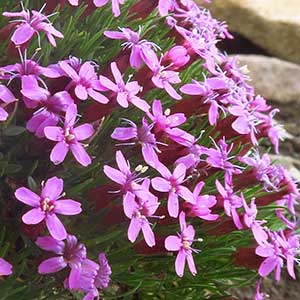Silene acaulis
Silene williamsii
moss campion, silène acaule
Williams' catchfly
several–many, decumbent to erect, much-branched and sometimes matted, leafy, 5–30 cm, pubescent and glandular, at least distally.
erect, leafy proximally, 3–6(–15) cm, old leaves persistent at base.
mostly basal, densely crowded and imbricate, sessile;
blade 1(–3)-veined, linear-subulate to lanceolate, 0.4–1(–1.5) cm × 0.8–1.5(–2) mm, margins cartilaginous, often ciliolate especially proximally, apex acute, glabrous to scabrous.
2 per node, leafy above, sessile;
blade narrowly lanceolate to elliptic-lanceolate, broadest proximally, narrowed to base, 1–5 cm × 3–8 mm, apex acute, short-pubescent and ± glandular on both surfaces.
solitary flowers.
cymose, loose, leafy, compound, or flowers terminal, axillary in distal nodes.
2–40 mm.
0.5–1(–3) cm, glandular-pubescent.
bisexual or unisexual, all plants having both staminate and pistillate flowers, others having only pistillate flowers, subsessile or borne singly on peduncle;
calyx 10-veined, lateral veins absent, tubular to campanulate, (5–)7–10 mm, herbaceous, margins often purple tinged, dentate, sometimes ciliate, ± scarious, glabrous, lobes lanceolate to ovate, 1–2 mm;
petals bright pink, rarely white, limb unlobed to shallowly 2-fid, 2.5–3.5 mm, base tapered into claw, auricles and appendages poorly developed;
stamens exserted in staminate flowers, not so or aborted in pistillate flowers;
styles 3.
unisexual, all plants having both staminate and pistillate flowers;
calyx obscurely 10-veined, ovate-campanulate, 9–11 × 4–6 mm, herbaceous, papery, pubescence rather dense, glandular, ± obscuring veins, veins slender, without conspicuous pale commissures, lobes lanceolate, ca. 2 mm, apex acute to acuminate;
corolla white, clawed, claw shorter than calyx, limb oblong, 2-lobed, 1.5–3 mm, lobes lanceolate, apex acute, appendages linear, 0.3–0.5 mm;
stamens equaling corolla;
stigmas 3, slender, equaling corolla, papillate only at tip.
3-locular, cylindric, equaling or to 2 times calyx, opening by 6 recurved teeth;
carpophore ca. 1 mm.
straw colored, ovoid-ellipsoid, slightly longer than calyx, opening by 6 teeth;
carpophore ca. 1 mm.
light brown, reniform, 0.8–1(–1.2) mm broad, dull, shallowly rugose.
dull brown, not winged, angular-reniform, ca. 1 mm, tuberculate.
= 24.
= 24.
Silene acaulis
Silene williamsii
Silene acaulis is a variable species, and most workers have recognized infraspecific taxa in North America: subsp. acaulis (subsp. exscapa and subsp. arctica), which is predominantly arctic; and subsp. subacaulescens, which extends down the Rocky Mountains from Alaska to Arizona and New Mexico. In subsp. acaulis, the leaves are flat and short and the flowers are subsessile and smaller in size. Subspecies subacaulescens is typically a larger, less-compact plant with longer, narrower leaves and larger, pedunculate flowers. However, in many populations, these two variants are poorly differentiated, and in others both occur together, connected by intermediates.
Silene acaulis is widely distributed in arctic and alpine Europe.
(Discussion copyrighted by Flora of North America; reprinted with permission.)
Silene williamsii is similar to S. menziesii but is readily separated by its leaves, which are broadest below the middle, its dull tuberculate seeds, and its stigmas, which are papillate only at the tip. It is also monoecious instead of functionally dioecious.
(Discussion copyrighted by Flora of North America; reprinted with permission.)


